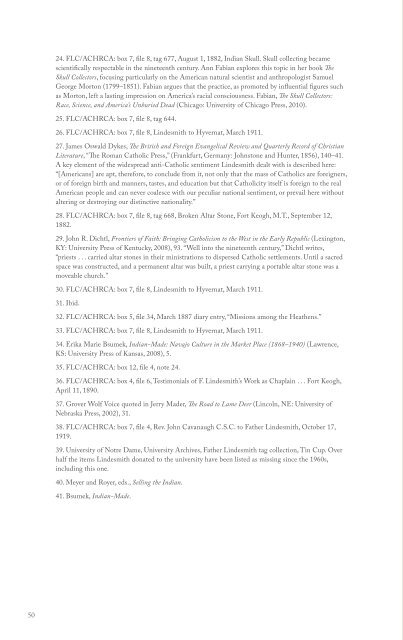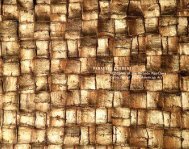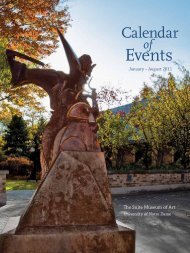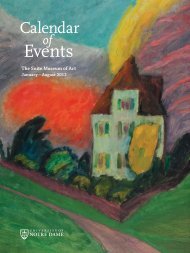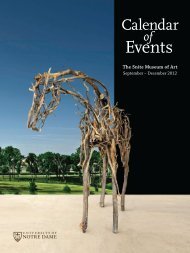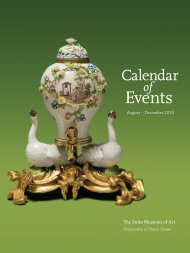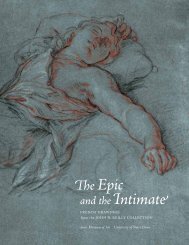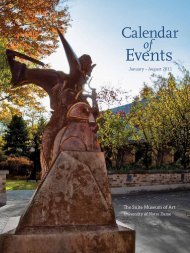HISTORY INTO ART AND ANTHROPOLOGY - Snite Museum of Art ...
HISTORY INTO ART AND ANTHROPOLOGY - Snite Museum of Art ...
HISTORY INTO ART AND ANTHROPOLOGY - Snite Museum of Art ...
Create successful ePaper yourself
Turn your PDF publications into a flip-book with our unique Google optimized e-Paper software.
24. FLC/ACHRCA: box 7, file 8, tag 677, August 1, 1882, Indian Skull. Skull collecting became<br />
scientifically respectable in the nineteenth century. Ann Fabian explores this topic in her book The<br />
Skull Collectors, focusing particularly on the American natural scientist and anthropologist Samuel<br />
George Morton (1799–1851). Fabian argues that the practice, as promoted by influential figures such<br />
as Morton, left a lasting impression on America’s racial consciousness. Fabian, The Skull Collectors:<br />
Race, Science, and America’s Unburied Dead (Chicago: University <strong>of</strong> Chicago Press, 2010).<br />
25. FLC/ACHRCA: box 7, file 8, tag 644.<br />
26. FLC/ACHRCA: box 7, file 8, Lindesmith to Hyvernat, March 1911.<br />
27. James Oswald Dykes, The British and Foreign Evangelical Review and Quarterly Record <strong>of</strong> Christian<br />
Literature, “The Roman Catholic Press,” (Frankfurt, Germany: Johnstone and Hunter, 1856), 140–41.<br />
A key element <strong>of</strong> the widespread anti-Catholic sentiment Lindesmith dealt with is described here:<br />
“[Americans] are apt, therefore, to conclude from it, not only that the mass <strong>of</strong> Catholics are foreigners,<br />
or <strong>of</strong> foreign birth and manners, tastes, and education but that Catholicity itself is foreign to the real<br />
American people and can never coalesce with our peculiar national sentiment, or prevail here without<br />
altering or destroying our distinctive nationality.”<br />
28. FLC/ACHRCA: box 7, file 8, tag 668, Broken Altar Stone, Fort Keogh, M.T., September 12,<br />
1882.<br />
29. John R. Dichtl, Frontiers <strong>of</strong> Faith: Bringing Catholicism to the West in the Early Republic (Lexington,<br />
KY: University Press <strong>of</strong> Kentucky, 2008), 93. “Well into the nineteenth century,” Dichtl writes,<br />
“priests . . . carried altar stones in their ministrations to dispersed Catholic settlements. Until a sacred<br />
space was constructed, and a permanent altar was built, a priest carrying a portable altar stone was a<br />
moveable church.”<br />
30. FLC/ACHRCA: box 7, file 8, Lindesmith to Hyvernat, March 1911.<br />
31. Ibid.<br />
32. FLC/ACHRCA: box 5, file 34, March 1887 diary entry, “Missions among the Heathens.”<br />
33. FLC/ACHRCA: box 7, file 8, Lindesmith to Hyvernat, March 1911.<br />
34. Erika Marie Bsumek, Indian-Made: Navajo Culture in the Market Place (1868–1940) (Lawrence,<br />
KS: University Press <strong>of</strong> Kansas, 2008), 5.<br />
35. FLC/ACHRCA: box 12, file 4, note 24.<br />
36. FLC/ACHRCA: box 4, file 6, Testimonials <strong>of</strong> F. Lindesmith’s Work as Chaplain . . . Fort Keogh,<br />
April 11, 1890.<br />
37. Grover Wolf Voice quoted in Jerry Mader, The Road to Lame Deer (Lincoln, NE: University <strong>of</strong><br />
Nebraska Press, 2002), 31.<br />
38. FLC/ACHRCA: box 7, file 4, Rev. John Cavanaugh C.S.C. to Father Lindesmith, October 17,<br />
1919.<br />
39. University <strong>of</strong> Notre Dame, University Archives, Father Lindesmith tag collection, Tin Cup. Over<br />
half the items Lindesmith donated to the university have been listed as missing since the 1960s,<br />
including this one.<br />
40. Meyer and Royer, eds., Selling the Indian.<br />
41. Bsumek, Indian-Made.<br />
50 51


